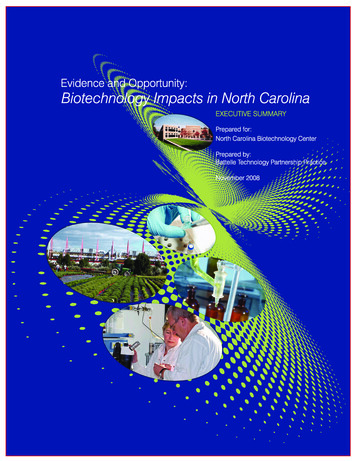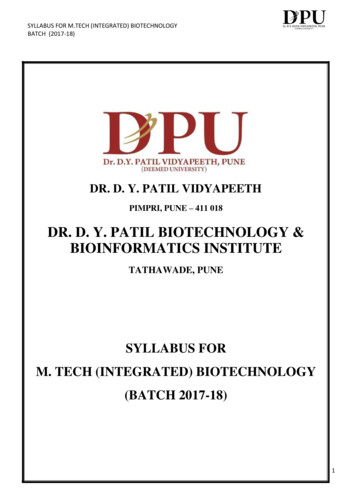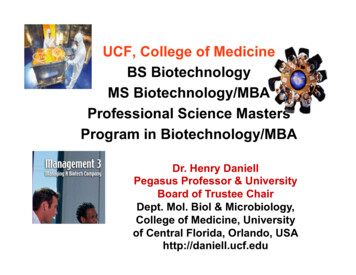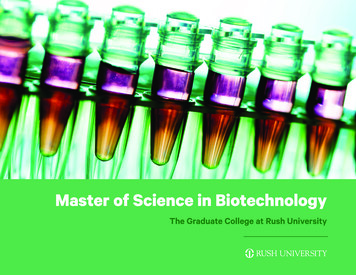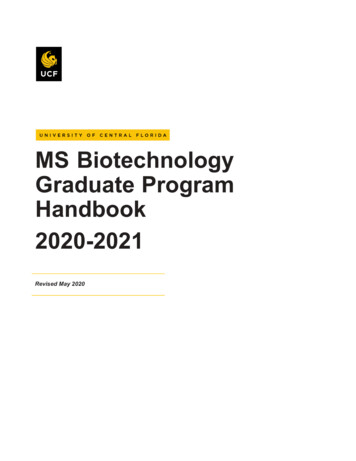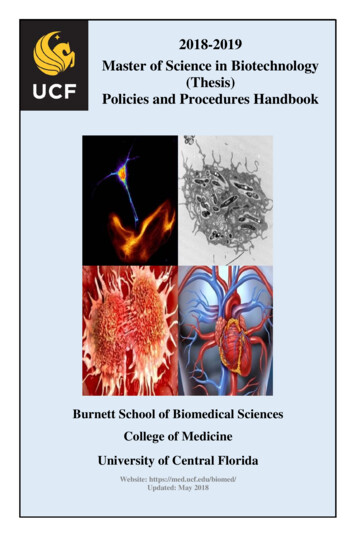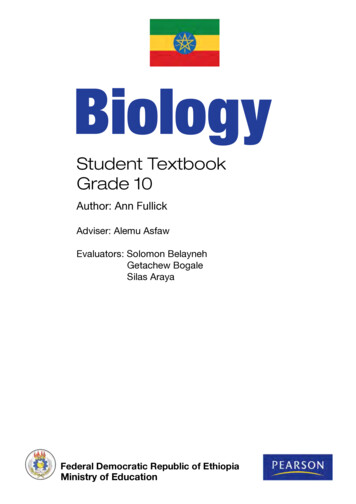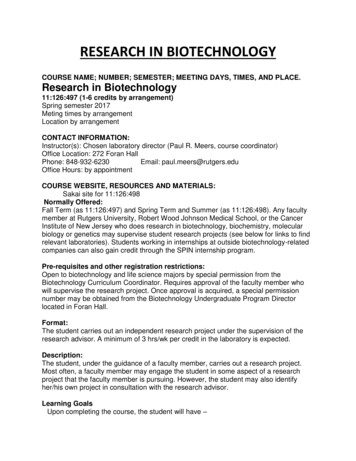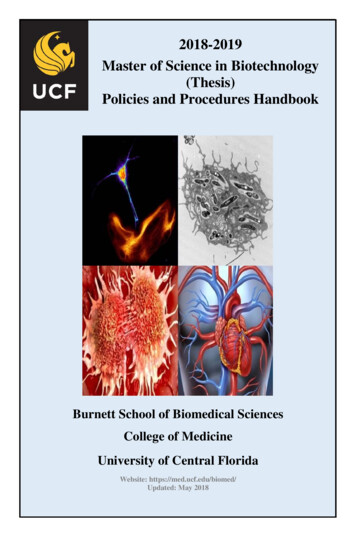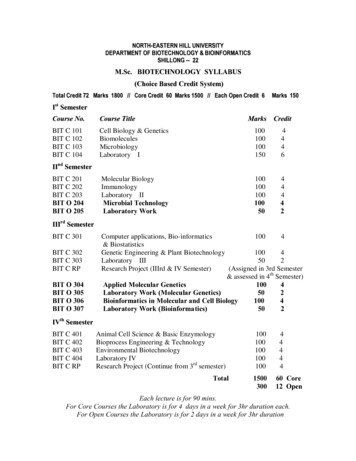
Transcription
NORTH-EASTERN HILL UNIVERSITYDEPARTMENT OF BIOTECHNOL OGY & BIOINF ORMATICSSHILLONG -- 22M .Sc. BIOTECHNOLOGY SYLLABUS(Choice Based Credit System)Total Credit 72 Marks 1800 // Core Credit 60 Marks 1500 // Each Open Credit 6Ma r k s 1 5 0Ist SemesterCourse No.Course TitleMarks CreditBIT C 101BIT C 102BIT C 103BIT C 104Cell Biology & GeneticsBiomoleculesMicrobiologyLaboratory – I1001001001504446Molecular BiologyImmunologyLaboratory – IIMicrobial TechnologyLaboratory Work1001001001005044442IInd SemesterBIT C 201BIT C 202BIT C 203BIT O 204BIT O 205IIIr d SemesterBIT C 301BIT C 302BIT C 303BIT C RPBIT O 304BIT O 305BIT O 306BIT O 307Computer applications, Bio-informatics1004& BiostatisticsGenetic Engineering & Plant Biotechnology1004Laboratory – III502Research Project (IIIrd & IV Semester)(Assigned in 3rd Semester& assessed in 4th Semester)Applied Molecular Genetics1004Laboratory Work (Molecular Genetics)502Bioinformatics in Molecular and Cell Biology1004Laboratory Work (Bioinformatics)502IVth SemesterBIT C 401BIT C 402BIT C 403BIT C 404BIT C RPAnimal Cell Science & Basic EnzymologyBioprocess Engineering & TechnologyEnvironmental BiotechnologyLaboratory IVResearch Project (Continue from 3rd semester)Total10010010010010015003004444460 Core12 OpenEach lecture is for 90 mins.For Core Courses the Laboratory is for 4 days in a week for 3hr duration each.For Open Courses the Laboratory is for 2 days in a week for 3hr duration
2Project:Student Seminar:Project will be based upon research and actual bench work. It will beginfrom IIIrd semester and will continue through the IVth semester. Projectreport will be submitted at the end of IVth semester and evaluated.Each student under the supervision of a faculty member will deliver acomprehensive seminar, which will be evaluated. The topic normallywill be from an emerging area of Modern Biology, Biomedical,Biotechnology or its applications.Laboratory I,II,III,IV: Independent practicals may be held under each course. However, forexamination purposes a single comprehensive 2-3 days practical be heldfor each semester, covering different courses offered during that semester.Invited lectures from Eminent Researchers, Industrialists and others, on recent issues related toBiodiversity, Ethics, Biosafety, Intellectual Property Rights and Patent Issues and Goodlaboratory and manufacturing practices will be organized.
3Ist SemesterB IT C 101CELL BIOLOGY AND GENETICS(Theory)Credit 4Unit-1Cell theory, Structure of prokaryotic and eukaryotic cells; Cellular organelles:Structural organization of Plasma membrane, cell wall, Mitochondria; Chloroplast andNucleus. Cell motility-cilia, flagella of eukaryotes and prokaryotes. Cell cycle: molecularevents and model systems.Cellular responses to environmental signals in plants and animals: mechanisms of signaltransduction (Rhizobium legume symbiosis, steroids, protein/peptides).Unit-2Transport of nutrients, ions and macromolecules across membranes. Cellular energytransactions- role of mitochondria and chloroplast.Extranuclear Inheritance: Genomes of mitochondria and chloroplast, Mitochondrial geneticdefects; Genetic Systems of Yeast and NeurosporaUnit 3Genome size and evolutionary complexity; Microbia l genetics: bacterial chromosomes andplasmids, conjugation, transduction and transformation in bacteria. Bacteriophages and theirgenetic systems. Lytic and lysogenic phases of l phage. Genetic recombination and itsmolecular mechanismUnit 4Human genetics: The human chromosome, chromosome abnormalities, Mendelian pedigreepattern, Hardy-Weinberg equilibrium, genotype and allelic frequencies; Inborn-errors ofmetabolism, polygenic and multifactorial inheritance; Sex-determination, role of Ychromosome, sex chromosome anomalies; Instability of the genome: Mutation-types,chromosomal aberrations, gene mutation, molecular basis of mutation,Suggested readings1.2.3.4.5.6.7.8.Molecular Biology of Cell, Alberts B et al. Garland Publishers, (2001)Molecular Cell Biology, Lodish et al. Scientific American Books (1995)Principles of cell and Molecular Biology, Kleinsmith LJ & Kish VM, Harper Collins CollegePublishers (1995).Cell and Molecular Biology, Karp G, John Wiley and Sons. (1999).Molecular Biology, Friedfelder D, Jones and Bartlett Publication, (1998).Principles of Genetics, Gardner EJ and Sunstad DP, John Wiley and Sons, (2000).Genetics, Strickburger MW, Macmillan Pub. Co., (1994).Human Molecular Genetics, Strachan T and Read AP, Garland Science, (2004).
4BIT C 102BIOMOLECULESCredit 4(Theory)Unit-1Chemical foundations of Biology: pH, pK, Henderson-Hesselbalch equation, acids, bases,buffers, weak bonds, covalent bonds.Quantitative Bioenergetics: Principles of thermodynamics, Gibbs energy changes, redoxreactions, equilibrium constants, concentration gradients, photons.Unit-2Classes of organic compounds and functional groups: Amino acids and peptides:classification, chemical reactions and physical properties. Sugars: classification and reactions;types, structural features, methods for compositional analysis.Heterocyclic compounds and secondary metabolites in living systems: nucleotides, pigments,isoprenoids, alkaloids, flavanoids, phenols. Lipids: classification, structure and functions.Unit-3Conformational properties of polynucleotides, polysaccharides and proteins: structuralfeatures and their analysis; Protein folding: biophysical and cellular aspects. Glyco andlipoproteins: structure and function. Protein-protein and protein-ligand interactions, physicaland chemical methods for study.Unit-4Separation techniques for different biomolecules: chromatography, electrophoresis, electrofocussing, centrifugation. Proteins: separation and purification and criteria of homogeneity,Ramachandran map. Physical techniques in protein, nucleic acids and polysaccharidestructural analysis: UV, LASER Raman Spectroscope, MASS Spectroscopy, FluorescenceSpectroscopy. Physical and chemical methods for immobilization of biomolecules. Nucleicacid hybridization.Suggested readings1. Essentials of Molecular Biology, David Friefilder, Jones and Barllett Publications, (2003).2.3.4.5.6.7.Proteins-Structure and Molecular Properties, TE Creighton, WH Freeman and company (2002).Genes VIII, B. Lewin, Oxford University Press, (2003).Harper’s Biochemistry, Murray RK et al., Prentice Hall International (1999).Physical Chemistry of Macromolecules, Tanford, C., John Wiley and Sons, (1998).Lehninger Principle of Biochemistry, Nelson DL and Cox MM, Worth Publishers, (2000).Biochemistry, Stryer I., H.Freeman and Company, (2000).
5BIT C 103MICROBIOLOGYCredit 4(Theory)U nit-1Introduction of microbiology and microbes, controversy over spontaneous generation, role ofmicroorganisms in transformation of organic matter and in the causation of diseases;Principles of -microbial nutrition; Construction of culture media; Enrichment culture techniquesfor isolation of nutritional categories. Microbial Growth: growth curve, Synchronous growth;Continuous culture; Influence of environmental factors on Growth; Culture collection andmaintenance of cultures.Unit-2Metabolic diversity among microorganisms: Photosynthesis; Chemolithotrophy; Hydrogen-ironnitrite-oxidizing bacteria; Nitrate and sulfate reduction; Methanogenesis and acetogenesis;Fermentations-diversity, Nitrogen metabolism .Microbial Diversity: Bacteria: Purple and green bacteria, cyanobacteria, acetic acid bacteria,Pseudomonads, lactic and propionic acid bacteria, endospore forming rods and cocci;Mycobacteria and Mycoplasms. Archaea: Halophiles; Methanogens; Hyperthermophilic archaea;Thermoplasma. Eukarya: Algae, Fungi, Slime molds and Protozoa.Unit-3Discovery, Classification and structure of viruses; Lysogeny; DNA viruses; RNA viruses;Replication; Viroids and Prions .Microbial Diseases: Disease reservoirs; Infectious disease transmission; Respiratory infectionscaused by bacteria and viruses; Tuberculosis; Sexually transmitted diseases including AIDS;Diseases transmitted by animals, insects and ticks, food and water borne diseases; Pathogenicfungi; Emerging and resurgent infectious diseases.Unit-4Host-Parasite Relationships: Normal microflora of skin, oral cavity, Gastrointestinal tract; Entryof pathogens into the host; colonization and factors predisposing to infections; types of toxins andtheir structure; Mode of actions; Virulence and Pathogenesis.Chemotherapy/Antibiotics: Antimicrobial agents; Sulfa drugs; Antibiotics: Penicillins andCephalosporins; Broad-spectrum antibiotics; Antibiotics from prokaryotes; Antifungalantibiotics; Mode of action; Resistance to antibiotics.Suggested readings1.General Microbiology, Stainer, RY, Ingraham, JL, Wheelis, ML., and Painter, PR. TheMacmillan Press Ltd., (2000).2. Principles of Microbiology, Atlas RM, Mosby, (1995).3. Microbiology, Davis BD et al., Harper and Row, (1990).4. Microbiology-Principles and exploration, Black JG, Prentice Hall, (1999).5. Microbial Biotechnology, Glazer AN, Nikaido H, WH Freeman and Company, (1995).
6BIT C 104LABORATORY 1Credit 6(Practicals)1. Microscopy: Bright field, Phase Contrast & Fluorescence microscopy.2. Sub-cellular fractionation; mitochondrion & chloroplast and their characteristic activities.3. Study of metaphase chromosomes from mouse/rat bone marrow/root tip.4. Study of meiosis from grasshopper testes/flower bud.5. Lymphocyte culture and preparation of chromosomes from human.6. Study of sister chromatid exchanges and chromosomal aberrations.7. Preparation of human karyotype.8. Quantitative reactions of amino acids, sugars, lipids, proteins and nucleic acids.9. Separation of DNA fragments by Agarose Gel Electrophoresis.10. Growth curve; Effect of temperature, pH and carbon and nitrogen sources on growth.11. Microscopic examination of bacteria, yeast and molds and study of organisms by Gramstain, acid fast stain and staining of spores.12. Assay of antibiotics and demonstration of antibiotic resistance.13. Isolation and maintenance of organisms by plating, streaking and serial dilution methods.Suggested readings1. Principles of Genetics, Gardner EJ and Snustad DP, John Wiley and Sons, (2000).2. Principles and Techniques of Practical Biochemistry, Wilson K and Walker J, Cambridge UnivPress, (1994).3. Human Molecular Genetics, Strachan T and Read AP, Garland Science, (2004).4. An introduction to Practical Biochemistry, Plummer DT, Tata McGraw Hill, (1987).5. Principles of Microbiology, Atlas RM, Mosby, (1995).
7IInd SemesterBIT C 201MOLECULAR BIOLOGYCredit 4(Theory)Unit 1Structure of DNA and its physico-chemical properties.Prokaryotic and eukaryotic DNA replication- DNA polymerases and proteins involved in DNAsynthesis and their specific roles. Structure and properties of RNA polymerases in prokaryotesand eukaryotes. General and specific transcription factors, Mechanism of transcription and posttranscriptional modifications of RNAs, RNA editing.Unit 2Features of genetic code, amino-acyl synthases and charging of t-RNA, prokaryotic andeukaryotic translation, regulation of translation. Synthesis of secretary and membrane proteins,import into nucleus, mitochondria, chloroplast and peroxisomes.Unit 3Regulation of gene expression: prokaryotic gene expression with reference to inducible andrepressible operons. Concept of eukaryotic gene regulation. Genetic basis of pattern formation inDrosophila, homeotic loci.DNA and RNA tumour viruse; oncogenes, tumour suppressor genes and their mechanism ofaction. Antisense RNA and RNA interference. Applications of antisense and ribozymetechnologiesUnit 4Importance of genome projects, human genome project, Sequence component of eukaryoticgenome, satellite, microsatellite and minisatellite DNA; physical mapping by building clonecontigs, genomic libraries, YAC, BAC libraries. General organization of human genome. Anoverview of gene expression in human cells, genetic markers, principles and strategies inidentifying disease genes, application of sequence information for identification of defectivegenes.Suggested readings1. Molecular Cloning: a laboratory manual, Sambrook J., Fritsch EF. and Maniatis T, Cold Springharbor Laboratory Press, (2000)2. Introduction to Practical Molecular Biology, DEabre P, John Wiley & Sons Ltd, (1998).3. Molecular Biology Labfax, T.A. Brown (Ed.), Bios Scientific Publishers Ltd. (1991)4. Molecular Biology of the Gene, Watson JD., Hopkins NH., Roberts JW., Steitz JA and Weiner AM(The Benjamin/Cummings Publ.Co.), (1996).5. Molecular Cell Biology, Darnell J, Lodish H and Baltimore D, Scientific American Books, USA,(2000)6. Molecular Biology of the Cell, Alberts B., Bray D, Lewis J., Ralf M., Roberts K. and Watson J.D.,Garland Publishing Inc. (2001)7. Gene IX, Lewin B, Oxford University Press, ( 2005).
8BIT C 202IMM UNOLOGY(Theory)Credit 4Unit 1Basic concepts in immunology, cells of immune system, innate and acquired immunity, clonalnature of immune response; Organization and structure of lymphoid organs, lymphocytetrafficking; Nature and biology of antigens, T- dependent, T-independent and superantigens.Unit-2Antibody structure and function, antigen-antibody interactions; Major Histocompatibilitycomplex, MHC gene organizations, Class I and Class II MHC molecules: structure and functions;B-cell receptor and T-cell receptor, generation of diversity; Complement system; Transplantation,graft vs host reaction, mixed lymphocyte reaction.Unit-3Regulation of immune system: Antigen processing and presentation to T-cells, activation of Band T-lymphocytes; Cytokines and their role in immune regulation, T-cell regulation, MHCrestriction; Immunological tolerance, immunomodulation.Unit 4Hypersensitivity: types, features and mechanism of immediate and delayed hypersensitivityreactions; immunity to microbes (protozoa, bacteria, fungi, intracellular parasites, helminthes &viruses); Immune to tumor; AIDS and immunodeficiencies. Hybridoma technology andmonoclonal antibodies; Vaccine: natural, synthetic &genetic, problem and prospect associatedwith development of vaccine for diseases like AIDS, Cancer and Malaria.Suggested Readings1.2.3.4.5.Molecular biology of the Cell, Alberts B., Bray D., Lewis J., Ralf M., Roberts K. and Watson J.D.,Garland Publishing Inc. (2001).Kuby Immunology, Goldsby R.A., Kindt Thomas J., Osbarne B.A., WH Freeman & Company,(2000).Immunology-Understanding the Immune System Elgert K.D, Wiley Liss, (1996).Roitt’s essential Immunology, Roitt I.M. and Delves P.J., Blackwell Science Ltd., (2001).Immunology 6th Edition, Roitt I., Brostoff J. and Male D., Mosby Harcourt Publishers, (2001).
9BIT C 203LABORATORY-IICredit 4(Practicals)1. Extraction of genomic DNA and RNA2. Study of semiconservative replication in mammalian cells.3. PCR amplification of genomic DNA.4. Gel electrophoresis of the PCR-product.5. Restriction endonuclease digestion of DNA.6. Separation of mononuclear cells by Histopaque.7. Isolation and identification of macrophages.8. Differential WBC count.9. Raising of antiserum in mouse/rabbit and immunodiffusion studies in agar gels.10. Antigen-antibody interactions in vitro-double immunodiffusion11. ELISASuggested readings1. Molecular Cloning: a laboratory manual, Sambrook J., Fritsch EF. and Maniatis T, Cold Springharbor Laboratory Press, (2000)2. Practical Biochemistry, Plummer L, Tata McGraw-Hill, (1990).3. Biochemistry, Stryer I., H.Freeman and Company, (2000).4. Roitt’s essential Immunology, Roitt IM and Delves PJ, Blackwell Science Ltd., (2001).5. Immunology 6th Edition, Roitt I, Brostoff J. and Male D, Mosby Harcourt Publishers, (2001).
10BIT O 204Microbial TechnologyCredit 4(Theory)Unit IMicrobial genetics: Replication, regulation of bacterial gene expression, mutations, genetictransfer, role of bacteria in cancer, DNA amplification using PCR – manipulation of geneexpression in prokaryotes ,– increasing protein production – expression and application in E. coil.Unit 2Nature of microbial polysaccharides, mechanism of synthesis; microbial transformation ofsteroids and sterols: screening for microbial products; microorganism for waste treatment;Immobilization of microalgae for pollutant removal.Bioprocess technology, beer brewing, cheese manufacture, mold–modified foods, Wine, Vinegar,The fermentation process , procedure and equipments.Unit 3Microbial production of amino acids, antibiotics, microbial enzymes, organic acids; methods forlaboratory fermentations, isolation of fermentation products, immobilized microbial cells and finechemicals. Strain improvement, culture preservation and inoculum development. Elementaryprinciples of microbial reaction engineering, Microbial culture selection, fermented foods,probiotics.Unit 4Microbes in agribiotechnology (livestock and transgenic plants); Introduction to bio-insecticides,candidate microbiology insecticides; biofertilizers, inoculant manufacture; diagnostic clinicalmicrobiology (emerging and re-emerging infectious diseases, microscopy, culture & sensitivity);microbes in production of alternative energy; microbial endophytes and novel metabolites;patenting.Suggested Readings1.2.3.4.5.6.7.General Microbiology, Stainer RY, Ingraham JL, Wheelis ML. & Painter PR. The MacmillanPress Ltd., (2000).Microbiology-Principles and exploration, Black JG, Prentice Hall, (1999).Microbial Biotechnology, Glazer AN, Nikaido H, WH Freeman and Company, (1995).Biochemical Engineering Fundamentals (2nd ed), JE Baily & DF Ollis, McGraw Hill Book Co.New York. 1986Bioprocess Technology: Fundamentals and Applications, KTH, Stockholm. 2000Bioprocess Engineering: Basic Concepts (2nded), ML Shuler, & F Kargi, Prentice Hall, EngelwoodCliffs. 2003Principles of Fermentation Technology (2nd edition), PF Stanbury, A Whittaker and SJ Hall,Pergamon Press, Oxford. 1995
11BIT O 205Microbial TechnologyCredit 2(Laboratory Work)1.2.3.4.5.Microbial population enumeration techniquesBiochemical identification of unknown bacteriaNucleic acid and plasmid isolationPCR and ElectrophoresisMicrobial Production of citric acid and antibiotics.Suggested Readings1.2.Microbiology-Principles and exploration, Black JG, Prentice Hall, (1999).Microbeal Biotechnology, Glazer AN, Nikaido H, WH Freeman and Company, (1995).
12IIIrd SemesterBIT C 301COMPUTER APPLICATIONS, BIOINFORMATICS &BIOSTATISTICSCredit 4(Theory)Unit 1Introduction of computer networks- Topologies and designs; Basics of computer operatingsystems-windows and Linux; Introduction to Markup language-Hyper Text MarkupLanguage (HTML) and Extensive Markup Language (XML); Spreadsheets and Presentationsoftware.Unit-2Introduction to internet and its application. Introduction to bioinformatics; Databse concepts,biological databases. Information retrieval from biological databases. Sequence alignmentand database searching-BLAST and FASTA. Pairwise and Multiple sequence alignment.Profiles, motifs and features identification.Unit-3Phylogenetic analysis. Extraction of a phylogenetic data set. Tree building methods: Treeevaluation. Comparative genome analysis. Reconstruction of metabolic pathways. Computational tools for expression analysis. Application of bioinformatics in drug designing.Unit-4Brief description and tabulation of data and its graphical representation. Measures of centraltendency and dispersion: mean, median, mode, range, standard deviation, variance.Idea of two types of errors and level of significance. Tests of significance (F & t test); Chisquare tests. Simple linear regression and correlation.Suggested readings1.2.3.4.5.6.Bioinformatics: A practical guide to the analysis of genes and proteins. Baxevanis A.D andOvellette B.F.F., Wiley-Interscience, (2002).Molecular and Biotechnology. A comprehensive desk reference, R.A. Meyes (Ed.) VCHPublishers Inc. (1995)Textbook of Bioctechnology Das H.K., Wiley Dreamtech India Pvt Ltd, (2004).Principles of Genome analysis and genomics, Primrose SB, Twyman RM, Blackwell Science(2002).Biostatistics-A foundation for Health Science, Daniel WW, John Wiley (1983).Statistical Methods, Medhi J, Willey Eastern Limited, (1992).
13BIT C 302GENETIC ENGINEERING AND PLANT BIOTECHNOLOGYCredit 4(Theory)Unit 1Molecular tools and their applications: Restriction enzymes, modification enzymes, production ofdefined DNA fragments, Gene cloning vectors and their use in various systems; Gene cloningstrategies- insertion of DNA molecule into a vector; the use of reverse- transcriptase, cDNA andRT-PCR; Detection of recombinant molecules, library construction and screening.Unit 2Study of gene regulation, DNA transfection, S1 mapping, RNase protection assay, reporter assay;Expression strategies for heterologous genes-in bacteria, in yeast, in mammalian cells and inplants. Site directed mutagenesis and knockout mutations, targeted gene replacement. Highthroughput genome sequencing, Functional proteomics and genomics- Yeast and Arabidopsis.Unit 3Different culture methods and regeneration protocols for plants; production of haploids, Planthormones and their role in development; embryo culture and embryo rescue technique; Artificialseeds; protoplast culture and fusion; regeneration of hybrid plants; symmetric and asymmetrichybrids, cybrids, cryopreservation, slow growth and DNA banks for germplasm conservation.Role of DNA markers with special emphasis on RFLPs, linkage analysis, RAPD markers, STS,EST, microsatellites, SCAR (sequence characterized amplified regions), SSCP( single strandconformational polymorphism), AFLP, map based cloning.Unit 4Transgenic organisms- vector and transformation in plants; transformation of monocots,transgene stability and gene silencing, chloroplast transformation; Application of planttransformation for productivity and performance: abiotic stress, use of ACC synthase,polygalacturanase, ACC oxidase, male sterile lines, bar and barnase system, terminatortechnology. Application of plant transformation for productivity, performance and resistance toinsects, nematodes, virus, RIP, coat protein mediated, disease resistance, PR proteins Biosafetyguidelines, IPR and ethical issues in biotechnology.Suggested readings1. Molecular Cloning: a Laboratory Manual, J Sambrook, E F Fritsch and T Maniatis, Cold Spring HarborLaboratory Press, New York, 2000.2. Methods in Enzymology Vol.152, Guide to Molecular Cloning Techniques, SL Berger and AR Kimmel,Academic Press, Inc. San Diego, 1998.3. Molecular Biotechnology (2nd Edn.) S B Primrose, Blackwell Scientific Publishers, Oxford, 1994.4. Route Maps in Gene Technology, M R Walker and R Rapley, Blackwell Science Ltd, Oxford, 1997.5. Genetic Engineering, An Introduction to gene analysis & exploitation in eukaryotes, SM Kingsman andA J Kingsman, Blackwell Scientific Publications, Oxford, 1998.6. Plant Biotechnology: J. Hammond, P. McGarvey and V Yusibov (Eds):, Springer Verlag, 20007. Plant Cell and Tissue Culture for the Production of Food Ingredients: T-J, Fu, G. Singh, and W R Curtis(Eds.):, Kluwer Academic/Plenum Press. 1999.8. Elements of Biotechnology: P K Gupta, Rastogi and Co. Meerut, 2007.9. An Introduction to Plant Tissue Culture: M K Razdan. Tata Mc Graw Hill Publishing Co. Ltd. 2004
14BIT C 303LABORATORY-IIIC r e di t 4Practicals1.2.3.4.5.6.7.8.Isolation of plasmid DNADNA amplification using polymerase chain reaction in plant system.Agarose gel electrophoresis and restriction digestion of DNA.Preparation of competent cells and Bacterial transformationCallus propagation and organogenesis.Anther culture.Computer applications and Bioinformatics (Biological database search).Statistical analysis of biological data.Suggested readings1.2.3.4.5.6.Molecular Cloning: a Laboratory Manual, J Sambrook, E F Fritsch and T Maniatis, Cold SpringHarbor Laboratory Press, New York, 2000.DNA Cloning: a Practical Approach, D M Glover and B D Hames, IRL Press, Oxford 1995.Plant Cell and Tissue Culture for the Production of Food Ingredients: TJ Fu, G. Singh and W RCurtis (Eds.), Kluwer Academic/Plenum Press. 1999.Practical Biochemistry, Plummer L, Tata McGraw-Hill, (1990).Bioinformatics: A practical guide to the analysis of genes and proteins. Baxevanis A.D andOvellette B.F.F., Wiley-Interscience, (2002).Molecular and Biotechnology. A comprehensive desk reference, R.A. Meyes (Ed.) VCHPublishers Inc. (1995)
15BIT O 304Applied Molecular GeneticsCredit 4TheoryUnit 1Protein-DNA interaction, regulation of transcription and translation, gene silencing in plants andanimals; Chromosome engineering, targeted gene replacement, Gene therapy.Molecular diagnosis of cancer, Oncogenes and tumor suppressor genes; Apoptosis, cell cyclecontrols and cancer.Unit 2Genes in development- Gene expression and body pattern formation (Fruiting body inDictyostellium, Vulva formation in Caenorhabditis, Hox gene and body patterning in vertebrates);Recent advances in developmental genetics and potential applications, prenatal diagnosis;Regulation of root, shoot and flower development, seed formation.Unit 3Genetic disorders of Hemoglobin; Diseases due to mutations in different classes of proteins,enzyme defects, disorders of structural proteins, neurodegenerative disorders; Identifying humandisease genes; Application of RFLP in forensic and disease prognosis; Genetic basis of plantpathogen interactions, R genes mediated disease resistanceUnit 4Genome projects in model organisms: Yeast, C elegans, Arabidopsis and rice genome projects,organization of human genome; Instability of the genome: Mutation-types, chromosomalaberrations, gene mutation, molecular basis of mutation, polymorphism, DNA damage andmechanism of DNA repair; Application of Molecular cytogenetic techniques: Chromosomebanding, chromosome FISH and GISH, chromosome painting and CGH- analysis.Suggested readings1.2.3.4.5.6.7.Genetics in Medicine, Thompson and Thompson, Saunders, (2004).Genetics: Analysis of genes and genomes, Hartl DA & Jones EW, Jones & Bartlett Publ., (2000).Molecular biology of the cell, Alberts B, Johnson A, Lewis J, Raff M, Roberts K, Walter P.,Garland Science, (2002).Gene IX, Lewin B, John Wiley and Sons, (2006).Human Molecular Genetics, Strachan T and Read AP, Garland Science, (2004).Biochemistry & Molecular Biology of Plants, Buchanan BB,Gruissen W & Jones RL, ASPP(2000).Molecular Cloning: a Laboratory Manual, J Sambrook, E F Fritsch and T Maniatis, Cold SpringHarbor Laboratory Press, New York, 2000.
16BIT O 305Applied Molecular GeneticsCredit 2Laboratory Work1.2.3.4.5.PCR amplification of genomic DNA.Reverse-transcription – polymerase chain reaction.Western Blot of regulatory protein of cell cycle / apoptosis.Preparation of metaphase chromosomes from cultured lymphocytes and cell lines.Genetic fidelity of tissue culture plants with RAPD markers.Suggested readings1.2.3.Human Molecular Genetics, Strachan T and Read AP, Garland Science, (2004).Biochemistry & Molecular Biology of Plants, Buchanan BB,Gruissen W & Jones RL, ASPP(2000).Molecular Cloning: a Laboratory Manual, J Sambrook, E F Fritsch and T Maniatis, Cold SpringHarbor Laboratory Press, New York, 2000.
17BIT O 306Bioinformatics in Molecular and Cell BiologyCredit 4TheoryUnit-1Database concepts, Introduction to internet and its application, Introduction to bioinformatics,Protein and nucleotide databases, Information retrieval from biological databases, Sequencealignment and database searching-similarity searches using BLAST and FASTA.Unit 2Molecular biology concept- Molecular markers (SNPs, VNTRs, 23SrRNA), Study of geneexpression by Microarray, Transcriptome, Expressed Sequence Tags (ESTs); regulation oftranscription.Sequence alignment-Pairwise, Multiple, local and global alignments, substitution, Insertions anddeletions in a sequence, statistical significance of alignments ;Gene structure predictionCENSOR, ReapetMasker; detection of functional sites in DNA sequences-PromoterScanand GenScan.Unit 3Substitution Scoring Matrices (PAM and BLOSUM) for protein sequences; Pattern anddomain databases-PROSITE, BLOCKS, PRINTS; motifs and profiles; Biomolecularinteraction-DNA - protein and protein- ligand interactions.Unit 4Protein structure-X-ray crystallography, The protein databank and the PDBSum-SCOP,CATH,DALI and HSSP ;Visualisation of molecular structures-RasMol and Pymol;Protein secondary structure prediction, Fold Recognition; Transmembrane topologyprediction.Suggested readings1.2.3.4.5.Bioinformatics: A practical guide to the analysis of genes and proteins. Baxevanis A.D andOvellette B.F.F., Wiley-Interscience, (2002).Molecular and Biotechnology. A comprehensive desk reference, R.A. Meyes (Ed.) VCHPublishers Inc. (1995)Textbook of Bioctechnology Das H.K., Wiley Dreamtech India Pvt Ltd, (2004).Principles of Genome analysis and genomics, Primrose SB, Twyman RM, Blackwell Science(2002).Human Molecular Genetics, Strachan T and Read AP, Garland Science, (2004).
18BIT O 307Bioinformatics in Molecular and Cell BiologyCredit 2Practicals1. Retrieval of protein and nucleotide sequences from suitable databanks2. Similarity searches using BLAST and FASTA3. Online tools for PCR primer generation and restriction analysis4. Visualization of genome maps-usage of Mapviewer from NCBI resourceSuggested readings1.2.3.Bioinformatics: A practical guide to the analysis of genes and proteins. Baxevanis A.D andOvellette B.F.F., Wiley-Interscience, (2002).Molecular and Biotechnology. A comprehensive desk reference, R.A. Meyes (Ed.) VCHPublishers Inc. (1995)Principles of Genome analysis and genomics, Primrose SB, Twyman RM, Blackwell Science(2002).
19IVth SemesterBIT C 401ANIMAL CELL SCIENCE AND BASIC ENZYMOLOGY Credit 4(Theory)Unit 1:Structure and organization of animal cell; Primary and established cell lines; Brief discussionon the chemical, physical and metabolic functions of different constituents of culturemedium; Role of carbon dioxide, serum and supplements; Serum & protein free definedmedia and their application. Basic techniques of mammalian cell culture in vitro,maintenance of cell culture; Cell synchronization. Measuring parameters of grow
Molecular Biology of Cell, Alberts B et al. Garland Publishers, (2001) 2. Molecular Cell Biology, Lodish et al. Scientific American Books (1995) . Molecular Cloning: a laboratory manual, Sambrook J., Fritsch EF. and Maniatis T, Cold Spring harbor Laboratory Press, (2000) 2. Introduction to Practical Molecular Biology, DEabre P, John Wiley .

